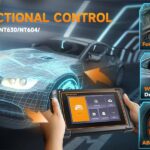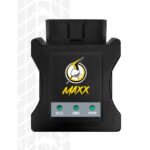Understanding your vehicle’s fuse box is crucial for troubleshooting electrical issues. This guide focuses on the 2004 Ford F150, specifically addressing the location of the OBD2 fuse and providing a comprehensive overview of its fuse box diagrams. A malfunctioning OBD2 port can prevent diagnostic tools from communicating with your truck’s computer, hindering proper troubleshooting.
Understanding the 2004 Ford F150 Fuse Boxes
The 2004 Ford F150 has three distinct fuse boxes: the passenger compartment fuse panel (also known as the power distribution box), and two auxiliary relay boxes, one with Daytime Running Lamps (DRL) and one without. Each box houses fuses and relays responsible for various electrical systems.
Passenger Compartment Fuse Panel: This panel, typically located under the dashboard on the driver’s side, contains the majority of the fuses for interior components and some exterior lighting. The OBD2 fuse, crucial for diagnostic connectivity, is located within this panel. Refer to your owner’s manual for the precise location of the OBD2 fuse within this panel. It is usually labeled as “Cigar Lighter” or “Diagnostic Connector Power”.
Auxiliary Relay Box (with DRL): This box often resides under the hood and houses relays primarily associated with engine functions and exterior lighting, including daytime running lamps.
Auxiliary Relay Box (without DRL): Similar to the previous box, this version lacks components specifically for daytime running lamps and may have slight variations in relay configurations.
04 Ford F150 OBD2 Fuse: Why It Matters
The OBD2 (On-Board Diagnostics II) port allows mechanics and car owners to access diagnostic trouble codes (DTCs) stored in the vehicle’s computer. These codes pinpoint malfunctions within various systems, enabling efficient troubleshooting and repair. A blown 04 Ford F150 Obd2 Fuse renders the port inoperable, making diagnosis difficult.
Troubleshooting a Non-Functional OBD2 Port
If your OBD2 scanner fails to connect, the OBD2 fuse is a prime suspect. Locate the correct fuse using your owner’s manual or the diagram provided above for the passenger compartment fuse box. Visually inspect the fuse for a broken filament or use a fuse tester for confirmation. Replace a blown fuse with one of the same amperage. Never use a higher amperage fuse, as this could damage the electrical system.
Common Causes of a Blown OBD2 Fuse
Several factors can contribute to a blown OBD2 fuse in a 04 Ford F150:
- Short Circuit in the OBD2 Port: Damaged wiring or a faulty diagnostic tool can cause a short circuit, blowing the fuse.
- Faulty Diagnostic Tool: Using an incompatible or malfunctioning scanner can overload the circuit.
- Overloaded Circuit: Other components sharing the same circuit as the OBD2 port may draw excessive current, leading to a blown fuse.
Conclusion
Knowing where to find and how to replace the 04 Ford F150 OBD2 fuse is essential for maintaining your truck’s diagnostic capabilities. This guide provides a clear overview of the fuse box diagrams and troubleshooting tips. Remember to consult your owner’s manual for specific fuse locations and amperage ratings. Regularly inspecting your fuses can help prevent unexpected electrical issues and keep your F150 running smoothly.


